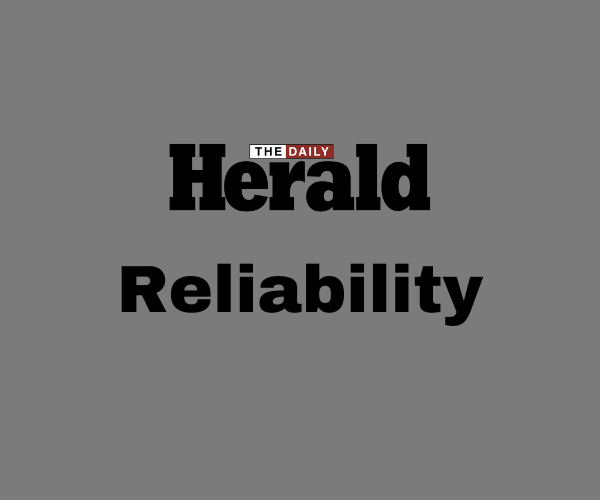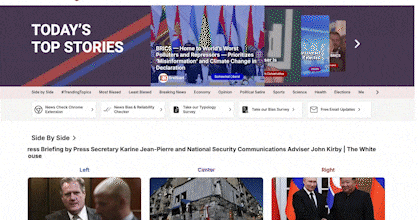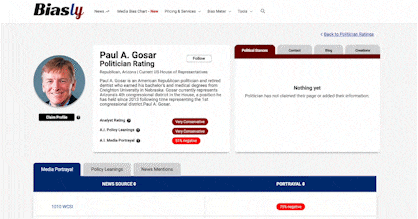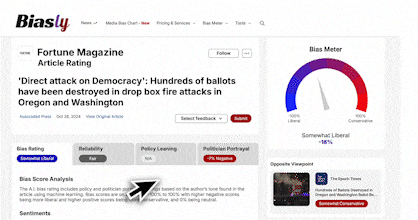
As of February 2022, Statista has found that 61% of people over 18 in the United States have a lot/some trust in the reliability of newspapers. Since The Daily Herald is a newspaper and online publication, it falls under this category. Even with a majority of consumers having some trust in the information they are receiving, it is still important to double-check what you are reading and see if credible sources are being used.
As the third largest newspaper in Illinois, The Daily Herald commands a substantial readership, making it even more critical to scrutinize the content they publish. Our goal is to ensure that their readers receive accurate information and can trust the veracity of the articles they consume.
Does Reliability Matter?
Reliability, in general, refers to how trustworthy or accurate information, or in this case, a news source is. If we consider this definition, it quickly becomes clear why reliability is important in media sources. If we can’t trust the things we read then there isn’t much of a point in continuing to consume content from that source, after all. So how exactly can we gauge the reliability of a news source anyways?
There are several potential measures of reliability to look out for when trying to determine whether a media source is reliable or not. Red flags for an unreliable article can include the presence of wild unsubstantiated claims, facts dependent on other unreliable sources, heavy use of opinionated language, and more. Some indicators of a reliable news source, on the other hand, include things like:
- Absence of subjective/opinionated language in articles
- Credible sources cited (e.g., neutral sources, .gov, .edu websites)
- Facts and statistics backed by multiple relevant outside sources
- Use of primary sources when possible (e.g., interviews, quotes)
- Information that remains consistent across news sources
So How Does The Daily Herald Fare in its Reliability?
The political reliability index developed by Biasly objectively assesses news organizations’ accuracy and trustworthiness. The Daily Herald’s overall Reliability Score has been rated as ‘Fair’ by Biasly. This rating is a weighted average of two distinct scores: the Fact Analysis Score and the Source Analysis Score, each evaluating separate components of The Daily Herald’s Reliability. When computing the Average Reliability of the article the Fact Analysis score is more heavily weighted. These ratings are as follows in the next two paragraphs:
The Daily Herald’s Fact Analysis Score is ‘Good,’ which suggests readers can trust most of The Daily Herald’s content online. The Fact Analysis score focuses more on the accuracy of claims, facts, and sources presented in the article and any hints of selection and omission bias, which we will discuss further in the article.
The Daily Herald’s Source Analysis Score is ‘Poor,’ which suggests readers can trust few of the sources, links, and quotes provided by the news source. This score, which is based on A.I., focuses on assessing the quality of sources and quotes used including their number, lengths, uniqueness, and diversity.
However, since these scores are based on percentages and averages, individual articles could be more or less trustworthy depending on the context, author, and other factors. Our findings show that The Daily Herald’s reliability is mostly but not all factual because they have retracted several stories in the past or had pieces that were not factual.
Let us analyze the supporting data for The Daily Herald’s rankings and discuss what to watch out for while searching for trustworthy news sources.
The Daily Herald Accuracy and Reliability
The credibility and reliability of a publication depend on multiple factors, such as the inherent bias and political leaning of the author. As a publication primarily serving Illinois, The Daily Herald hasn’t undergone extensive national scrutiny regarding the reliability of its content. In this analysis, we aim to identify any potential selection or omission bias, which are key to evaluating the accuracy and factuality of the articles.
Selection bias refers to the intentional selection or deselection of stories or facts based on ideological grounds to fortify a narrative aligned with the news source’s ideology. Omission bias, conversely, involves excluding diverse opinions or political viewpoints from a piece, thereby presenting readers with only the ideological perspective endorsed by the author. Recognizing these biases is critical to assessing the accuracy of an article.
Biasly uses a reliability metric ranging from one to a hundred, where one denotes the least reliability and a hundred marks the utmost reliability. Multiple factors contribute to this score, such as the adequacy of supporting evidence for statements, and the number of internal and external sources cited, among others. When looking up a source on Biasly, you can find the bias and reliability scores for recently published articles from that particular source. The Daily Herald, for instance, received an 80% reliability score from analysts. However, individual article reliability can fluctuate depending on the presence of selection bias and especially omission bias.
A case in point can be seen in The New York Times, which Biasly rates as ‘Moderately Liberal’ with an overall reliability score of 71%. One of their articles titled “U.S. Defends Detention of Afghan at Guantánamo Despite Pullout,” received a reliability score of 90%, while another, “Justice Department Warns States on Voting Laws and Election Audits,” scored only 42%. This demonstrates how even within a single source, reliability can vary significantly.
For example, an article by The Daily Herald, “Chicago Public Schools employees ask U.S. Supreme Court to hear challenge to union dues,” was rated Somewhat Liberal by analysts. The author cited few sources and primarily focused on the school employees’ viewpoint, thereby overlooking a balanced perspective. The article received a Somewhat Liberal score due to its supportive stance on socialized policies such as union rights, which in today’s political climate, leans more liberal. Additionally, the author, Sarah Mansur, tends to have a more left-leaning tilt in her politics. Analysts found her sources reliable, indicating her article’s trustworthiness.
We will continue to delve deeper into the reliability of The Daily Herald’s articles in the next section of this article, paying close attention to the presence of selection and omission bias, and the quality of the sources and facts utilized.
Analysis of Reliability in The Daily Herald Opinion Pieces
Discussing the intersection of reliability and opinion pieces can be nuanced. Opinion pieces, by nature, allow authors to openly express their views on various topics, which can sometimes cast doubts on their trustworthiness. However, when it comes to political discourse, these pieces can provide valuable insights by presenting viewpoints that differ from those of the readers, thereby fostering a broader understanding of the issues at hand.
Quality of Sources and Facts Used
As discussed above, intertwining reliability and opinion pieces can sometimes be difficult, and we can see that in this article titled, “Barone: The gathering storm,” the Author, Michael Barone, only used eight quotes, and of these, six are short and two were medium length. Along with the quotes, his eight sources for this article are:
- Andrew Roberts’ biography of Lord Northcliffe (Member of the House of Lords of the United Kingdom)
- Arthur Herman’s “Freedom’s Forge” (Forbes)
- Liberal writer Ezra Klein (The New York Times)
- Liberal writer Derek Thompson (The Atlantic)
- Steve Vogel’s “The Pentagon” (The Washington Post)
- Eric Larrabee’s “Commander in Chief”
- Former Pentagon official Elbridge Colby
- A statement made by President Joe Biden
While it’s evident that the sources Barone employs are credible and trustworthy, a notable issue arises with the sparse use of direct quotes from them. Frequent reference to these sources in the article often takes the form of paraphrasing or brief three-word quotes. For example, two quotes he uses are:
We can see here that he uses two extremely short quotes from President Biden and that is all. This limited use of direct quotations can undermine the perceived credibility of the sources, leading the reader to question why more content wasn’t directly quoted to support the author’s opinion if the source is indeed reliable. Furthermore, it’s noteworthy that the quotations Barone chose to include are statements made by individuals rather than statistical data. Paying attention to both the length and nature of the quotes is a crucial consideration in assessing an article’s reliability.
Selection and Omission Bias
The article “Harrop: We need two parties to fix the border. We now have only one” serves as an apt case study of selection and omission bias. The author, Froma Harrop, predominantly criticizes the Republican party, describing it as useless on several occasions. The Democratic party receives only a couple of negative remarks, clearly indicating her preference. This article illustrates selection and omission bias since it pins the country’s problems solely on one political party. Problems of national magnitude usually carry a complex historical context, and assigning exclusive blame to one party is an oversimplification. The article includes only three brief quotes, one of which is from New York City’s Mayor Eric Adams regarding the migrant placement issue, and it says:
““This issue will destroy New York City,” Mayor Eric Adams said. The strains, he adds, will cost the city more than $12 billion over three years.”
Drawing parallels with the previously analyzed article “Barone: The gathering storm,” we observe similar issues. Barone adopts a negative tone towards several past Democratic leaders, such as President Joe Biden, Barack Obama, FDR, and Woodrow Wilson, painting the Democratic party in an unfavorable light. The relatively less negative commentary about Republican politicians exposes a clear bias. For example Barone wrote this about President Biden:
“But in time, he may need to answer why he and his appointees and colleagues in the Obama administration tilted U.S. policy toward Hamas’ patron Iran, to the point of releasing $6 billion to Iran in September and appointing an Iranian sympathizer and possible spy to a national security post.”
It can be seen here that Barone is giving off a negative tone towards President Biden and Obama by saying they may have appointed a possible spy in a security post. An excessively negative portrayal of one political party can compromise the article’s reliability by indicating a one-sided perspective devoid of diverse viewpoints.
Both opinion pieces exhibit glaring instances of selection and omission bias, accuracy issues, and challenges with credible sources. However, the fact that articles like Harrop’s get published in The Daily Herald – despite its right-leaning leaning reputation – signals that the publication attempts to represent a range of political opinions across Illinois, even if individual writers may not maintain impartiality.
So is The Daily Herald Reliable?
In conclusion, The Daily Herald can be regarded as a reliable news source that generally publishes articles substantiated by credible sources, albeit with some exceptions. As a consumer, being well-informed about media reliability and credibility enables you to trust the information you consume. While the hustle and bustle of daily life might not afford you the time to meticulously vet every article, Biasly’s News Bias Checker simplifies this task. This tool is designed to help you assess the reliability of an article or a news outlet, as well as guide you towards more trustworthy news sources.

























